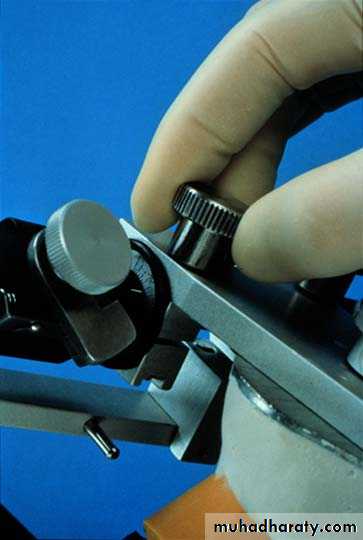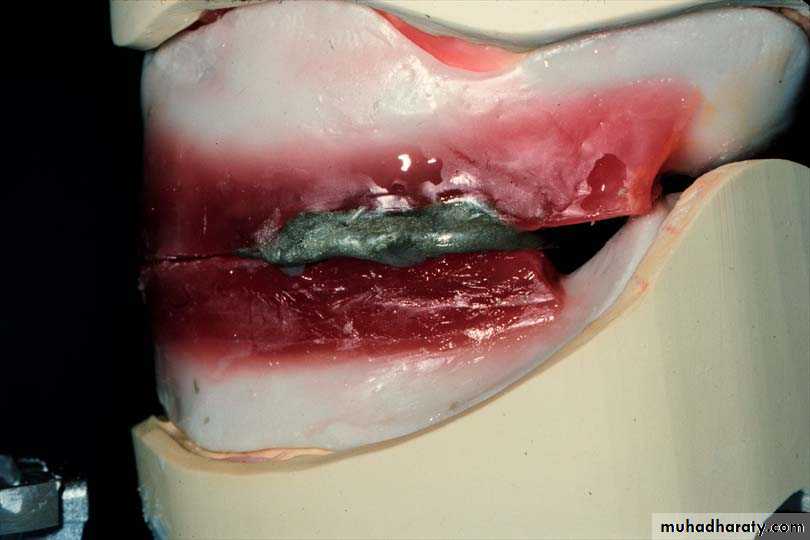Horizontal relations
Compensating Curve [ Glossary of Prosthodontic Terms]• is the“antero-posterior curvature* (in the median [sagittal] plane) and the medio-lateral curvature** (in the frontal plane) in the alignment of the occluding surfaces and incisal edges of artificial teeth that are used to develop balanced occlusion.”
• “The curve introduced in the construction of complete dentures to compensate for opening influences produced by the condylar and incisal guidances during lateral and protrusive mandibular excursive movements-called also the compensating curvature, compensating curve”
• * = Curve of Spee in the natural dentition
• ** = Curve of Wilson in the natural dentition
Each condyle moves about 3 axes
Vertical
Sagittal
Horizontal
Movements of the mandibleHinge like movement used in opening & closing the mouth for introduction of food & crushing brittle food
Protrusive movement used in the grasping & incision of food
Right or left lateral movements use in the reduction of fibrous foodBennett movement the bodily side shift of the mandible which when it occurs may be recorded in the region of the rotating condyle on the working side
The lower incisor mesial point angle* scribes out the classical Posselt’s Envelope of Motion shape in the sagittal plane that is the extreme (maximum) border movement of the mandible limited by bone, ligaments, muscles and occlusal contact. Most functional movements are intraborder movements
* An envelope of motion will be scribed out by any location on the mandible (including the condyle) but although having the same characteristics, will have different proportions and size.
“Hinge Axis” (Horizontal Axis)
Is repeatable when the condyles are maximally seated in Centric Relation: & is then called the “Terminal Hinge Axis”Jaw manipulation about the posterior border of movement in the initial 20-26mm of opening is about the terminal hinge axis (opening about the hinge or horizontal axis with the condyles in Centric Relation)
Border movement
A average movement in sagital plane4-1 terminal hinge movement (border movement)
1-6 opening exceeding hinge movement (border movement)
6 maximal opening
4 retruded contact position or maximum intercuspation
4-3 tooth contact from centric occlusion in straight protrusion following cingulae of maxillary anterior teeth
3-2 edge to edge contact
2-5 protrusion of mandibular anterior teeth beyond the maxillary anterior teeth
4-5 guided by tooth contact (intra border movement)
5 contact in maximum protrusion
5-6 movement from maximal protruded contact to maximal opening
B horizontal movement area
C movement in three planes
4
5
2
3
4-1
1
6
Physiologic rest position
The position assumed by the mandible when the head is in an upright position, the muscles are in equilibrium in tonic contraction, and the condyles are in a neutral, unstrained position.Significance
• It is a bone to bone relation in a vertical direction.
• In the absence of pathosis the relation is fairly constant throughout life.
• It can be recorded in acceptable limits
• It is used in determining the vertical dimension of occlusion.
• the most retruded physiologic relation of the mandible to the maxillae to and from which the individual can make lateral movements. It is a condition that can exist at various degrees of jaw separation. It occurs around the terminal hinge axis
• the most retruded relation of the mandible to the maxillae when the condyles are in the most posterior unstrained position in the glenoid fossae from which lateral movement can be made, at any given degree of jaw separation
Eccentric relation any relation of the mandible to the maxillae other than centric relation
Protrusive relation is the relation of the mandible to the maxillae when the mandible is thrust forward
Right & left maxillomandibular relation are the relations of the mandible to the maxillae when the mandible is moved either to the right or left side
When to Use Centric Relation
When entire occlusion being restoredNo remaining posterior centric stops
When complete, fixed, or removable partial dentures involve the entire occlusion
When to Not to Use Centric Relation
Stable occlusionNo pathology
Posterior centric stops present
No valid reason to change
Use maximum intercuspation
Requirements for making centric relation record:
to record the correct horizontal relation of the mandible to the maxillae.to exert equalized vertical pressure.
to retain the record in undistorted condition until the casts have been accurately mounted on the articulator
Methods used to make centric relation record :
Functional (chew in) :The Patterson technique and the Needles – House technique are examples of the functional method. Both are based on same principle. The patient produces a pattern of mandibular movements by moving the mandible to protrusion, retrusion, and right and left lateral.
The Needles – House technique uses compound occlusion rims with four metal styli placed in the maxillary rim. When the mandible moves with the styli contacting the mandibular rim, the styli cut four diamond shaped tracings. The tracings incorporate the movements in three planes, and the records are placed on a suitable articulator.
The Patterson method uses wax occlusion rims. A trench is made in the mandibular rim and a mixture of half plaster and half carborundum paste is placed in the trench. The mandibular movements generate compensating curves in the plaster and carborundum. When the plaster and carborundum are reduced to the pre determined vertical dimension of occlusion, the patient is instructed to retrude the mandible and the occlusion rims are joined together with metal staples.
Graphic method :
The graphic methods record a tracing of mandibular movements in one plane, an arrow point tracing. The apex of properly made tracing presumably indicates the most retruded relation of the mandible to the maxillae from which lateral movements can take place.Graphic methods are either intraoral or extraoral, depending upon the placement of recording device. The extra oral tracing is preferable because it is more accurate, visible and large.
• Tactile or inter occlusal check record :
• The tactile or inter occlusal check record method is referred to as a physiologic method. The normal functioning of the patients properioception and tactile sense is essential in the making of an accurate record.• The records are made using a recording medium (impression plaster, zinc oxide eugenol, impression compound and wax) between the occlusion rims or the trial denture bases. The patient closes into the recording medium with the lower jaw in its most retruded position and stops the closure at a predetermined vertical relation.
A number of methods have been described to assist the patient in retruding his mandible :
• instruct the patient by saying : “let your jaw relax, pull it back, and close slowly and easily on your back teeth.”• instruct the patient by saying :”get the feeling of pushing your upper jaw out and closing your back teeth together.”
• instruct the patient to protrude and retrude the mandible repeatedly.
• instruct the patient to turn the tongue back ward toward the posterior border of the upper denture.
• instruct the patient to tap the occlusion rim or back teeth together repeatedly.
• Tilt the patient head back while the various exercises just listed are carried out.
• Palpate the temporalis and masseter muscles to relax them.
Registering Centric Relation
Occlusion rim notched to aid stabilizing the record bases
•
• Index fingers on the rim, thumbs under symphysis
Preparing Occlusion Rims
Place 3 widely separated lines between the rims in the centric position (mid line & canine eminences)Check that record base heels(rims do not touch)
Registering Centric Relation
Two sharp “V”-shaped notches in the molar/premolar area of each sided wax depth 1-2 mmEnsure adequate notch depth
Too Shallow
1-2 mmThin Layer of Material
Too Thick
Check RecordHave patient close into record
Ensure smooth arc of closure, no horizontal deviations
Medium on sides of rim can causes deflection
Registering Centric Relation
Place Alluwax into a 1-2mm slot in maxillary rimFill to slight excess
Ensure wax is dead soft
Hot water bath for softening (use care)
Keep Wax Neat
Registering Centric RelationStabilize mandibular record base using index fingers on the flange (or in a recess in the rim) and the thumbs under the symphysis
• Hold position until set 1-2 min
• Remove both rims together• Chill and separate
Registration Should be Sharp, Not Rounded
Registering Centric RelationMounting the Mandibular Cast
Ensure record is repeatableIncrease the height of incisal pin 1 mm, invert articulator
Place wax rims together, lute with sticky wax - 4 spots
Registering Centric Relation
Mount the mandibular cast with mounting plasterReturn the incisal pin to contact when rims contacting without centric record
Occlusion rims should be touching evenly, over the entire occlusal surface
Do not alter incisal pin after rims closed to contact
Otherwise, position of correct vertical dimension can be lost
Protrusive Records
Balanced occlusionUsed to set the condylar guidance
Protrude a minimum of 5-6 mm
Registration material placed bilaterally, posterior to the canines
Patient closes with mandible positioned anteriorly
Protrusive Records
Material must interdigitate with the opposing “V-shaped” notchesMake at height greater than the established occlusal vertical dimension
Wax is removed, chilled
Condylar elements are released from hinge position
Instrument protruded, and the records approximated
Factors that affect the centric relation record :
Resiliency of the tissues supporting the denture bases.Stability and retention of record bases.
The tempro-mandibular joint and its neuro muscular mechanism.
Technique employed in making the records.
Amount of pressure applied in making the records.
The skill of the dentist
Eccentric relation record :
The purpose of these records is to adjust the articulator to simulate the eccentric movements (lateral and protrusive) of the mandible to the maxillae. This adjustment permit arrangement of the teeth in balanced occlusion. The records are made in the same manner as for centric records, for lateral movement record, Hanu recommend the following formula :
L=(H/8)+12
L :lateral condylar inclination degree.
H :horizontal condylar inclination degree.












































